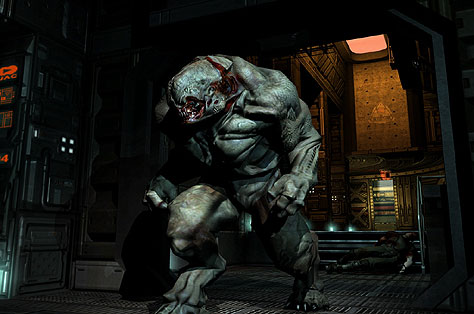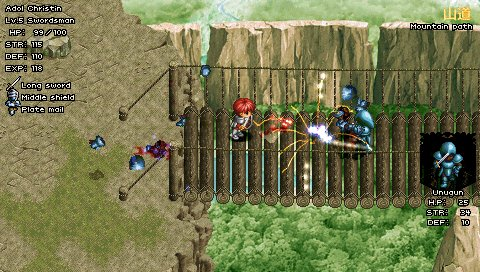Last updated on August 15, 2013
Thanks to the Steam sale, I own every Ys game available in English currently available on the PC. Honestly, I never imagined the opportunity would arrive, given my lack of a PC Engine/TurboGrafx-16 in my younger years, but the year 2013 helped out with that! I may lament the current state of the game market, but I certainly don’t lament the availability of older titles and remakes!
So, for a quick recap: some know Ys as Japanese developer Nihon Falcom’s flagship JRPG series revolving around a red-haired man, his descendants, and a bunch of gods/goddesses that do things, get reincarnated, and all other sorts of trouble. Although it plays similar to a Zelda game with exploration on a open world map, things to kill and equipment to find/buy, there’s a surprisingly in-depth story (for 1989 standards, anyway) with an entire metaphysical system attached.
That’s all well and good, but Ys appears a rout and generic version of The Legend of Zelda by that criteria. Rather, the unique element of the early Ys games derives from its combat system. Called the “Bumping” System, Ys takes a different, more fast-paced note on traditional overhead combat. Unlike Link, who uses a separate button press to dispatch foes, Adol’s a little more direct. Lacking an attack button, you ram your fiery-haired protagonist into the nearest enemy, thereby causing him/her/it massive damage. It’s unbelievably hilarious the first time you do it, simply because your brain’s been trained to press a button and attack.
There’s nothing quite like the feeling of plowing through an enemy, knocking him what looks like a hundred feet back like a giant medieval lawnmower. The system certainly isn’t harmed by Adol’s movements speed, which is less Link-type methodical and more bladed-freight train of death. He zooms around the screen at a consistently fast clip, enough so that getting used to such quick combat and decision making feels strange at first.
What makes it so satisfying comes from the skill requirement. You cannot just throw your caution to the wind and hope to live. Even though the game operates on a eight-axis control scheme, bumping takes a little precision. You need to hit enemies a little bit off center to take out damage; hit them straight into the front and you will take damage as well. Enemies ARE strong, and will more-than-likely kill you (even with equipment upgrades!), so it’s not an innocuous choice. Sure, you could go hit and run, but nailing that perfect off-kilter angle and smacking some stupid tree guy upside the head is priceless. It’s a perfect combination of risk and reward, and it’s an unbelievably lovely system in craft and design.
Of course, the age of Ys I (the version I am currently playing) doesn’t hold your hand in this, so save and save often never applied in so great a measure! I’ve literally died 10-20 times just in the first area WITH equipment trying to get the timing down, and I don’t think it really clicked until I saw a video. Thank the Lord for Youtube, because seeing other angles felt nigh-impossible. As my parents told me (and my pre-first grade Readiness year taught me), I am good at picking up complex concepts, but extremely bad at the more common-sensical things; that is certainly the case with bumping!
I imagine that’s why the town and dialogue set themselves right into the comfortable JRPG tropes and niches. Every town you talk to every villager (sometimes, it’s mandatory for progress), learn a great deal about the world and mythos, laugh a bit, get some upgrades, and generally do RPG-like things in a slow paced environment. This offers a great break in pacing from all the craziness outside – it doesn’t ease the game’s learning curve for a modern audience, but it certainly helps in lightening the load from the constant flow of combat.
“Flow” perfectly describes Ys I. The combat, especially, reminds me of that perfect connection between what your brain knows to do and what your hand-eye coordination can process at the same time, a dual melding of mind and body. To depart to philosophical pasture, we can imagine “flow” as “play”. We’re interacting with the game’s systems in a particular way based on the whims and ideas of the developers. After engaging with enough game systems, you notice the niggling inconsistencies of its mechanics.
Take DooM 3, for example. If you play any version of it, I would recommend avoiding the new BFG version and play the original. Yes, the new one fixes many graphical elements and brings the game “into the modern age”, whatever that means, but it’s not just a cursory touch-up. The new one fixes things that weren’t necessarily broken. The primary example is the flashlight and gun being separate implements in the original PC and Xbox releases.
Much of the game takes place in dark spaces, so forcing the player to use a flashlight or a gun in exclusion to the other means you make a choice when you’re confronted with a room with a monster…somewhere. Do you go for low light conditions with a heavy machine gun, or will visibility save your bacon and help you find a card key? It’s an interesting decision that the developers remove entirely in the BFG remake due to “fan demand”. I wager it goes against the spirit of Doom 3 to make the flashlight so accessible from the outset and changes the dynamic entirely, making it little more than a poor, and really dark, version of DooM 1 or 2. That’s a sad state of affairs, and it removes a lot of the tension and decision-making – i.e., integrating yourself into the “play” of the game. Aesthetic elements rarely bring you out of the experience, but mechanical ones (including glitches) often will.
With that understanding, what we call “play” isn’t the primary but the medial element in the equation. Players like us do not directly control play – after all, by choosing the game itself we submit to its rules – but are caught up in it by choice. Play isn’t played by a subject, but it is absorbs the players into its intricacies; the subject, in this case, is actually the game. Between the game and the player, we have “play”, and that’s the mediating element between them. The player is not merely a zombie, and the game itself does not totally control me (after all, I can quit when I want…or can I?), so this reflects play’s medial status.
Going back to Ys, the game demands that I submit to its rules. I can’t just complain about how fast Adol dies, or how long it takes to grind, or how the enemy suddenly turned to face me right as I began to bump him – these are part of the rules of the game. There’s an optimal strategy, but it takes time and persistence to figure out. Until I finally submit and learn the game’s rules, the “play” doesn’t fully emerge; I’m sure everyone has this learning experience at one point or another.
In that sense, there’s a constant pushing and pulling between both parties here that gives us flow. Once I, the player, accept the mechanics and ideas laid before me and perform as the game demands (with the player’s own creativity and ingenuity within that closed system), then the play can begin. Neither side conquers the other, but we give up our choice in order to play with something or someone else. We conform to the set of rules, and there’s a freedom in that. Or, as Hans-George Gadamer says in his metaphor of hermeneutics:
the to and fro of constantly repeated movement [and] . . . what characterizes this movement back and forth is that neither pole of the movement represents the goal in which it would come to rest. … a certain leeway clearly belongs to such a movement. … This freedom is such that it must have the form of self-movement.
Of course, Gadamer says that the goal of play is to continue playing, and this explains a bit of why games that refuse failure remain unsatisfying. I certain give my choice to the game, but there’s no movement, push-and-pull, or flow. I can’t lose, so the “play” of the game immediately ends as soon as I choose to play the game. There’s nothing to mediate. There’s a certain lack of investment and engagement; we do not enter that “flow” state that reciprocates in a wonderfully engaging feedback loop with the game, but we simply ask it to roll over and give a win screen. Without actual choice and risk, there’s little to be found in a game; that’s in the very essence of the attraction of play – a lose state.
The second element of play, apart from its medial nature, comes from the element of self-presentation. I’m sure you hear video games are fantasy simulators, because I certainly want to become a soldier in the United States Army (surprise: I don’t!). But, as stated earlier, we submit to the rules of the game in order to create play. In a strategy game where war exists, for example, we must represent ourselves (or the game does, natch) as something else; this is simply part of the nature of games in general.
The self-presentation of human play depends on the player’s conduct being tied to the make-believe goals of the game, but the “meaning” of these does not in fact depend on their being achieved. Rather, in spending oneself on the task of the game, one is in fact playing oneself out. The self-presentation of the game involves the player’s achieving, as it were, his own self-presentation by playing—that is, presenting—something. Only because play is always presentation is human play able to make representation itself the task of the game.
If that sounds complicated, it’s not. The goals of the game aren’t the goals of the player, obviously; there’s not a 1:1 ratio between myself playing a military shooter and actually motivating myself to shoot another person. And, of course, the goal of the game comes from the self-accomplishment of mastering its mechanics and continuing to play the game. Most games happen to end in the world of video games, but the principle still applies.
Thus, we see that play isn’t so much a reflection of ourselves, and our actions in games do not represent my own. They do, however, represent my desire to play within the arbitrary limitations of the game and continually play so as to master. It’s why video gamers continue to play new games – most games end or become boring, and the play must continue for new games to learn and new systems to master (or becoming competent, at least).
It’s that single-minded focus of the gamer that makes them so engaging and wonderful; Ys just represents one example among many. If you focus on the right things in a game, you will ultimately succeed. Freedom, then, implies a lack of choice by definition. I choose Christ because it is true what happened two thousand years ago. I set my eyes on the prize because my faith remains wholehearted and steady no matter what. As long as I submit to the Law of grace and the Lord who is Love, it’s difficult to go wrong, isn’t it? Colossians 3 says this well enough:
Therefore if you have been raised up with Christ, keep seeking the things above, where Christ is, seated at the right hand of God. 2 Set your mind on the things above, not on the things that are on earth. 3 For you have died and your life is hidden with Christ in God. 4 When Christ, who is our life, is revealed, then you also will be revealed with Him in glory.
Who said video games never teach you anything?


